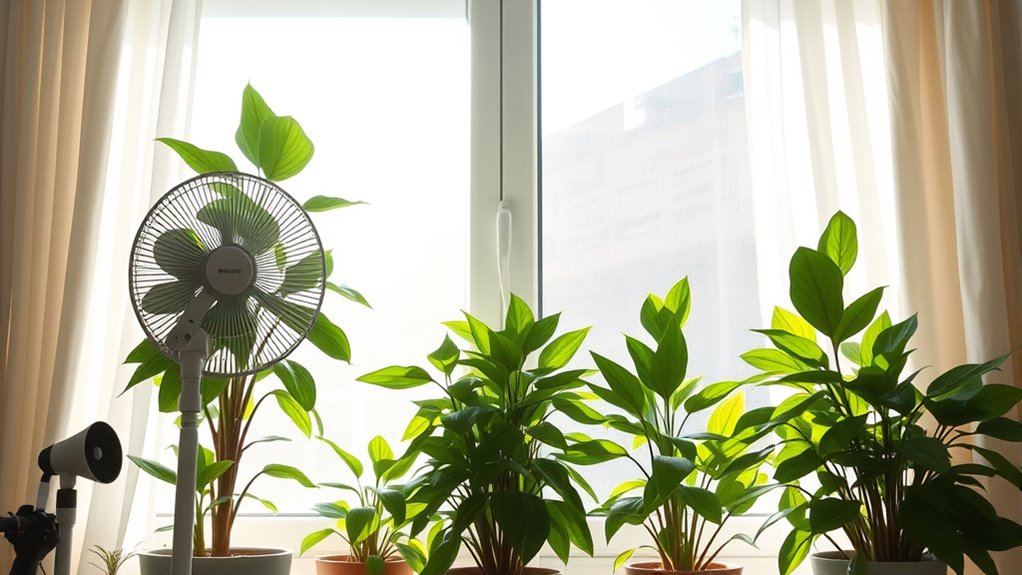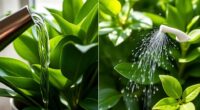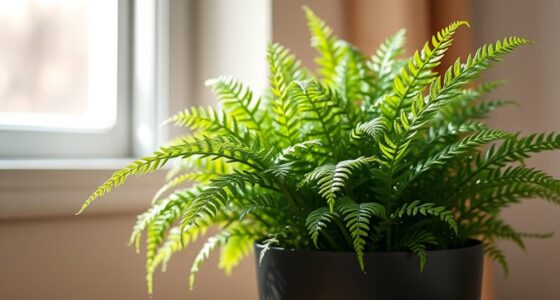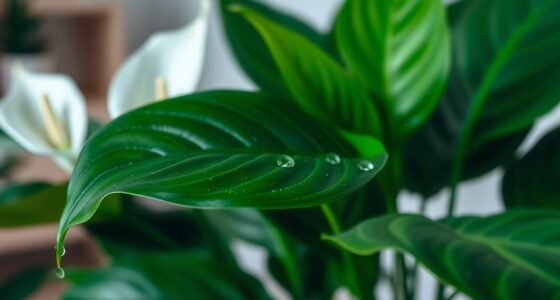During a heatwave, it’s important to adjust your care routine to protect indoor plants from stress. Increase watering to keep the soil consistently moist, but avoid waterlogging. Move plants away from direct sunlight and use sheer curtains or diffusers to lessen light intensity. Keep windows open in cooler parts of the day and use fans for airflow. Monitoring conditions and making these small changes can make a big difference—learn more tips to keep your plants healthy during extreme heat.
Key Takeaways
- Increase watering frequency to keep soil consistently moist without causing waterlogging.
- Move plants away from direct sunlight and use shade coverings or indirect light.
- Improve indoor airflow with open windows, fans, or strategic placement away from heat sources.
- Monitor soil moisture daily and adjust watering based on plant needs and environmental conditions.
- Keep indoor temperatures stable and avoid placing plants near radiators or heat-emitting appliances.
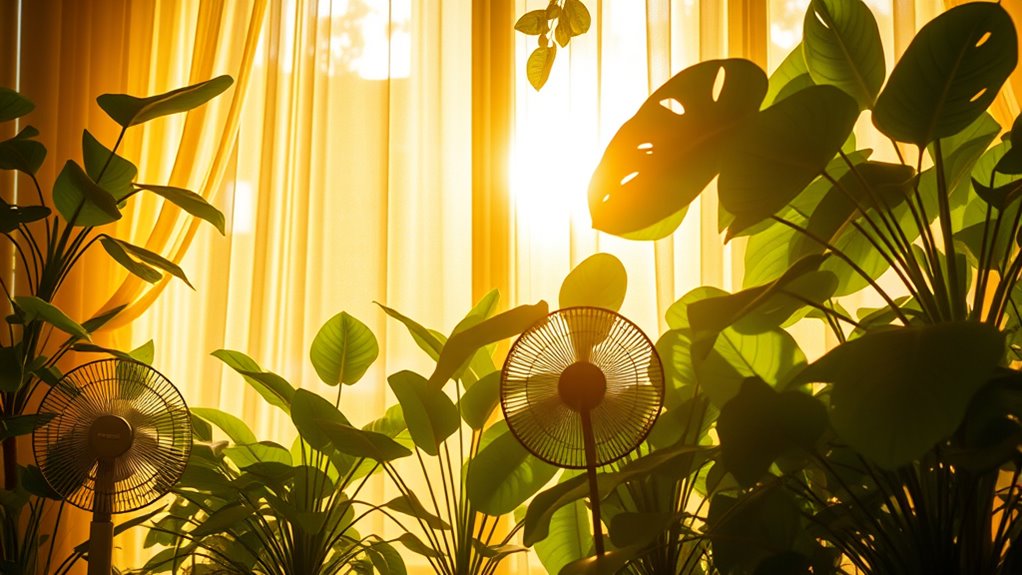
During a heatwave, indoor plants can quickly become stressed if you don’t take the right precautions. The intense heat and increased sunlight can cause dehydration, leaf scorch, and even plant death if you’re not careful. To keep your plants healthy, you need to pay close attention to their watering frequency and shade placement. These are essential factors that can make a significant difference during extreme summer heat.
First, assess how often you’re watering your plants. During a heatwave, they lose moisture faster due to higher temperatures and stronger sunlight. You’ll want to increase your watering frequency, ensuring the soil stays consistently moist but not waterlogged. Check the top inch of soil daily; if it feels dry, it’s time to water again. Avoid letting the soil dry out completely, as this can stress the roots and lead to wilting. On the other hand, don’t overwater, as excess moisture can cause root rot. Balance is key, and adjusting your routine based on your plant’s specific needs and the indoor environment is critical.
Check soil daily during heatwaves; keep it moist but avoid waterlogging to prevent stress and root rot.
Another essential step is shade placement. Direct sunlight during a heatwave can scorch leaves and cause stress, especially if your plants aren’t accustomed to intense light. Move your plants away from direct sunbeams and place them in areas with indirect light or dappled shade. If you have plants that thrive in bright light, consider using sheer curtains or blinds to diffuse the sunlight. You can also create shade by positioning plants behind larger furniture or near walls that don’t reflect heat. Proper shade placement reduces the risk of leaf burn and helps maintain a more stable temperature around your plants, which is important during extreme heat.
Additionally, monitor the indoor environment itself. Keep the windows open during cooler parts of the day to promote airflow and reduce indoor temperatures. Use fans if necessary to circulate air gently around your plants. Avoid placing plants near heat sources like radiators, vents, or appliances that emit heat, as these can compound the stress caused by the heatwave. Incorporating high-quality grow lights can also help supplement light without increasing heat stress, especially in dimmer indoor spaces.
Frequently Asked Questions
How Can I Identify Heat Stress in My Indoor Plants?
You can identify heat stress in your indoor plants by observing signs like wilting, yellowing leaves, or browning edges. Check if the plant’s humidity levels are too low, causing dehydration. Also, monitor sunlight exposure—excessive direct sunlight can increase heat stress. If you notice these symptoms, adjust humidity, reduce direct sunlight, and make certain of proper watering to help your plants recover and thrive.
Are There Specific Indoor Plants More Resilient to Heat?
They say, “A little resilience goes a long way.” When it comes to indoor plants, some are naturally tougher against heat. Succulent varieties like aloe and jade, along with tropical favorites like pothos and dracaena, tend to handle higher temperatures better. You can keep them thriving by providing proper light and watering. These hardy plants are your best bet for enduring extreme summer heat indoors.
What Signs Indicate My Plant Is Suffering From Heat Damage?
When your plant shows signs of heat damage, look for leaf scorch, which appears as browning or crisp edges on the leaves. You might also notice plant dehydration, with wilting or drooping stems, and dry, brittle leaves. These symptoms indicate your plant is struggling with the heat and needs immediate relief, such as moving it to a cooler spot, increasing humidity, or providing more water to prevent further damage.
Can Indoor Fans Help Regulate Temperature for Plants?
Indoor fans can definitely help regulate temperature for your plants by improving air circulation. Proper fan placement is key—you want to position fans to gently move air around your plants without causing direct drafts, which can dry out leaves. This increased airflow helps prevent heat buildup, reduces humidity issues, and promotes healthier growth. Just remember to keep fans on a low setting and avoid pointing them directly at your plants.
How Often Should I Adjust Watering During a Heatwave?
Worried about watering during a heatwave? Worry not! You should adjust your watering frequency based on soil moisture monitoring—check your plants daily. When the heat is high, water more frequently to keep roots refreshed, but avoid overwatering. Observe your plants for signs of thirst, like drooping leaves. Consistent checking and adjusting will keep your indoor plants healthy, hydrated, and happy amidst the heat.
Conclusion
Remember, your indoor plants are like delicate flames—requiring careful tending to burn brightly without damage. During a heatwave, your attention becomes the shield that guards their essentiality, turning your home into a sanctuary of resilience. Just as a steady hand preserves a flickering candle, your thoughtful actions nurture their growth amid the heat’s chaos. In protecting them, you guarantee they continue to symbolize life’s perseverance, glowing softly even in the harshest summer days.

